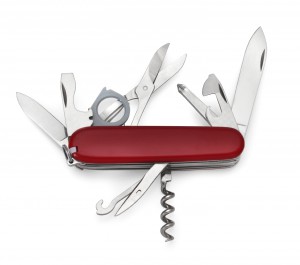We’re continuing to reflect on the “10 Principles of Good Design” as applied to supply chain and supply chain management (Design for the Supply Chain). This week we’re talking about being able to use supply chain management tools in an uninhibited way.
Principle #5: Good design “Is unobtrusive”
“Products fulfilling a purpose are like tools. They are neither decorative objects nor works of art. Their design should therefore be both neutral and restrained, to leave room for the user's self-expression.” – ‘Dieter Rams: ten principles for good design’
I really like the idea of leaving room for the user's self-expression. To me this means making sure there’s space for creativity and innovation (Principle #1). We need to have parameters or ‘guardrails’ in place to ensure that proper business process flow is occurring, otherwise it becomes hard to produce consistent results.
On the other hand, we have exceptional professionals who are capable of bringing new ideas to bear on the supply chain design. We want the user to be able to take the designated management tools (e.g. reports, multi-dimensional analysis, dashboards, scorecards, etc.) and reconfigure them to see information in a way that makes the most sense to them individually (recall Principle #4). We also want the user to be able to create scenarios to experiment with various ideas about what can be changed to improve results.
One example I’m reminded of is Noveon, who used existing tools and ‘tapped into people power’ as a source of innovation. They created a team charged with focusing on supply chain and sourcing process improvements. The team didn’t have operational duties, just the task of looking for new ways of doing business. In addition, Noveon also leveraged logistics interns from a nearby college to look at the management reports and manipulate the data to provide new insights (Mixing Up an Innovative Culture - Noveon Inc.).
This company got benefit and tangible results from their approach of opening up things for exploration but I wonder if it’s an approach that limits the potential for wider “self-expression”. I understand and agree with using ‘fresh eyes’, but I’m convinced that if we do it right we can create an organization-wide culture of improvement that will have a much higher multiplier in terms of ideas generated and improvements realized.
Ideally we want the tools to be simple and flexible enough for the folks in daily operations to be able to surface new ideas versus teams or individuals who are outside of daily execution. We just need to make sure the tools don’t get in the way… In terms of Industry 4.0, I believe the development of data integration protocols will allow users to plug-and-play new supply chain data into their existing management tools which will facilitate their ability to explore new theories.
I think of it like adding apps to my phone, then being able to make them talk to each other and finally presenting the results in a way that actually encourages me to think about it differently. Our job will be to make sure that the management tools allow this flexibility for users to explore new avenues of optimization while being simple to use for daily execution within operational objectives.
Do you have an example of a user creatively using a management tool to uniquely identify improvement opportunities?
Want to learn more about Design for the Supply Chain? Check out the rest of the series:





Leave a Reply